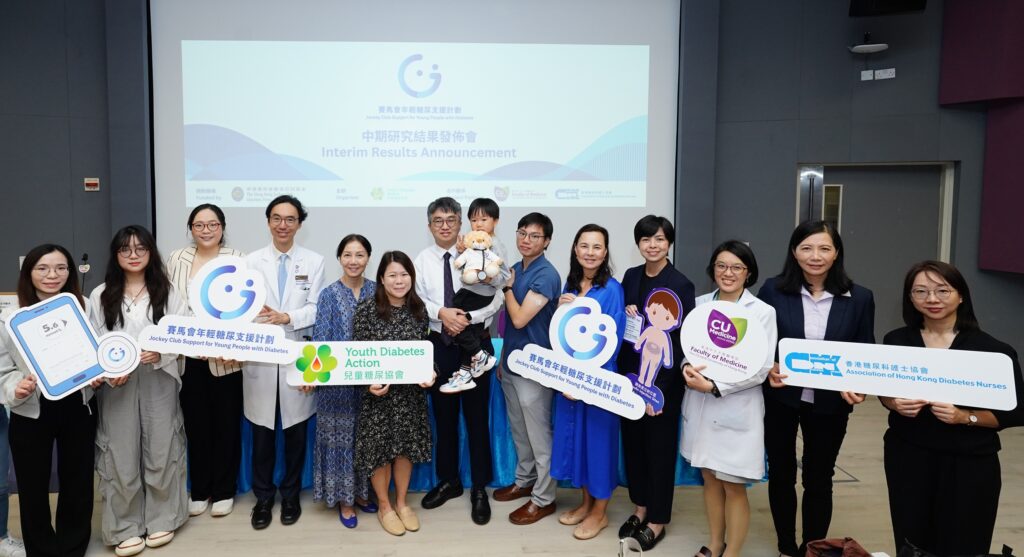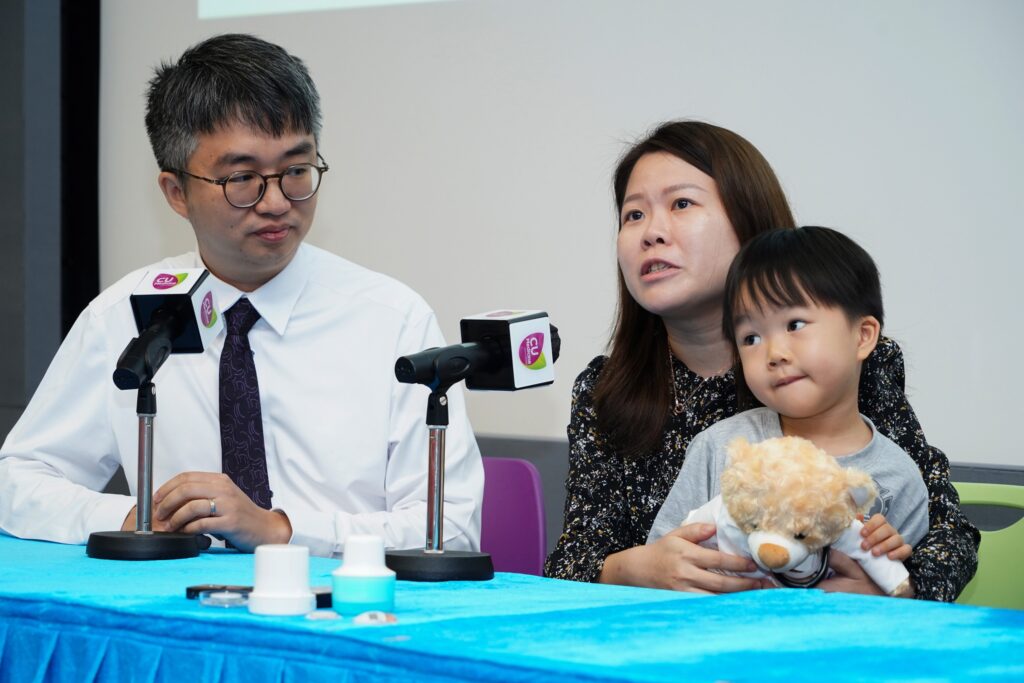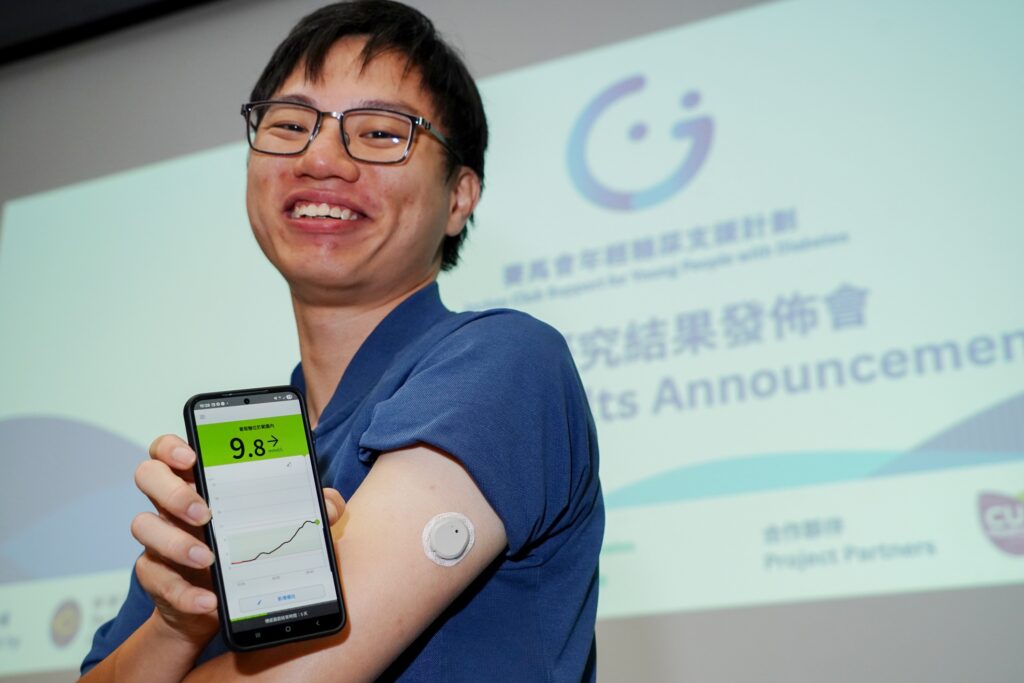Interim Results Announcement of JC Support for Young People with Diabetes
To mark the World Diabetes Day on 14 Nov, the “Jockey Club Support for Young People with Diabetes” held a press conference on 13 Nov to share its mid-term findings. Since its launch in 2023, the programme has supported over 900 young people with diabetes through CGM devices and education.
Here is the full version of press release.
13 November 2025
Over 900 young people with diabetes provided with continuous glucose monitors
significantly reduce the risks of severe hypoglycaemia and ketoacidosis
Since its launch in 2023, the “Jockey Club Support for Young People with Diabetes” has provided continuous glucose monitors (CGM) and diabetes management education to over 900 young people living with the disease since its launch in 2023. Analysis of the data show that continuous use of a CGM for 12 months significantly improves overall blood glucose levels in young people with diabetes. Furthermore, the hospitalisation rate due to diabetic ketoacidosis dropped significantly, by 85%, while the risk of severe hypoglycaemia leading to hospitalisations reduced by over 60% and that of severe hyperglycaemia by over 50%. This demonstrates that CGM technology can effectively help individuals to self-manage their condition and substantially reduce the risk of severe complications.
Improved self-management of Type 1 diabetes can reduce risk of severe complications
Diabetes is a common condition characterised by chronic elevation of blood glucose. If not well controlled, it can lead to acute diabetic emergencies and long-term complications such as blindness and kidney failure. Diabetes is broadly divided into Type 1 diabetes, Type 2 diabetes and gestational diabetes. While Type 1 diabetes is traditionally the most common form seen in children, increasing obesity and other factors have contributed to increasing rates of young people being affected by Type 2 diabetes. It is estimated that more than 4,000 people are living with Type 1 diabetes in Hong Kong, China, including about 800 aged below 30. It is also estimated that more than 600,000 people are living with Type 2 diabetes in the city.
Due to the destruction of pancreatic insulin-producing cells, people with Type 1 diabetes depend on multiple daily insulin injections to maintain their blood glucose levels. They are particularly vulnerable to developing severe hypoglycaemia (low blood glucose) or diabetic ketoacidosis. Severe hypoglycaemia is not uncommon in young people with diabetes. Local research indicates that annually, for every 1,000 young people or children with Type 1 diabetes, 35 of them experience severe hypoglycaemic complications, which can lead to coma if not treated promptly.
Recent developments in diabetes technology have made it possible to monitor glucose levels continuously, providing a much more comprehensive assessment of glucose control compared to multiple daily finger-prick tests. These technological advances have also made it possible to link CGMs with devices such as insulin pumps, allowing for better glucose control. The provision of CGMs and insulin pumps is rapidly becoming the standard of care for Type 1 diabetes in many regions, and has resulted in improved glucose control and reduced risk of complications.
Sustained CGM use shows effective blood glucose control
This leading programme is made possible thanks to the generous support from the Hong Kong Jockey Club Charities Trust. Organised by Youth Diabetes Action (YDA) and The Chinese University of Hong Kong (CUHK)’s Faculty of Medicine (CU Medicine), this major initiative is to provide CGMs to young people living with diabetes in Hong Kong. The project is also supported by the Association of Hong Kong Diabetes Nurses (AHKDN), which provides diabetes management education. Over the past two years, the project has provided continuous CGMs to more than 900 people with diabetes, including 837 with Type 1 diabetes.
Interim analysis of the project data has highlighted the significant benefits of CGM use. Among the first 644 participants in the analysis, 388 (60.4%) were not regular CGM users before joining the programme. There was a significant improvement in overall glucose control after both six and 12 months of CGM use in all participants. Average glucose control, as reflected by Glycated hemoglobin (HbA1c), decreased from 7.8% to 7.4% at six months, which was maintained at 12 months, in people with little CGM experience. Improvements in HbA1c were seen in all groups with baseline HbA1c above the optimal target of 7%. After 12 months, there was a significant reduction of 85% in the rates of hospitalisation with diabetic ketoacidosis, while severe hypoglycaemia fell by more than 60% and hyperglycaemic crises by more than 50%.
Ms Stella Lau, Executive Director YDA, remarked: “We are deeply grateful to the Hong Kong Jockey Club Charities Trust for supporting this important initiative, which has allowed people living with diabetes in Hong Kong, China to benefit from the life-changing technology provided by CGM. enabling children and young people with diabetes to be less worried about the fears of severe hypoglycaemia and to be able to live healthier lives.”
Dr Elaine Chow Yee-kwan, Associate Professor (Clinical) in the Department of Medicine and Therapeutics at CU Medicine, said: “CGMs have transformed the lives of many people living with diabetes worldwide, and we are delighted that our programme has demonstrated the important benefits of CGMs in our local population of young people with diabetes. Severe hypoglycaemia is associated with significant risks, and the marked reduction of the condition when using CGMs is highly encouraging.”
Professor Ronald Ma Ching-wan, S.H. Ho Professor of Diabetes and Head (Academic Affairs) in the Division of Endocrinology and Diabetes at CU Medicine, commented: “The interim results from this study have shown the tremendous benefit of CGM technology for young people with diabetes, with substantial reductions in hospitalisation and severe complications from hyperglycaemia and hypoglycaemia, together with overall improvements in glucose control. We are excited about the potential for this type of technology to benefit the increasing number of young children and adults being diagnosed with diabetes, especially those with Type 1 diabetes requiring insulin injections. We hope more people with diabetes can benefit from this technology in the future.”
Professor Juliana Lui Nga-man, Assistant Professor and a health economist at the Department of Medicine and Therapeutics at CU Medicine, noted: “The significant reduction in hospitalisation with severe hypoglycaemia and diabetic ketoacidosis within 12 months after starting continuous CGM use is associated with a significant reduction in medical costs. We are currently conducting a more comprehensive analysis, taking into account the additional potential benefits of improved glucose lowering in reducing multiple complications, to provide a full assessment of the cost-effectiveness of CGM provision.”






Appendix
About Jockey Club Support for Young People with Diabetes programme
The four-year “Jockey Club Support for Young People with Diabetes” programme is supported by generous donations from the Hong Kong Jockey Club Charities Trust. It is co-ordinated by Youth Diabetes Action, and supported by CU Medicine and the Association of Hong Kong Diabetes Nurses (AHKDN). The programme aims to improve support for people with diabetes by providing access to CGMs and resources to empower individuals and their families to better manage their diabetes. Additionally, the programme will help to raise awareness of diabetes, as well as study the cost-effectiveness of CGM usage in people with diabetes.
About Youth Diabetes Action
Youth Diabetes Action (YDA) was established over 20 years ago with the mission that no child is held back because of diabetes. Children with Type 1 diabetes must rely on a controlled diet, frequent blood glucose monitoring, and daily insulin injections to stay alive. YDA provides emotional and financial support, advocates for improved treatment access, and offers care and counselling services to children and adolescents with diabetes and their families. Additionally, YDA organises educational, community, and fundraising activities to raise public awareness and deepen understanding of the challenges faced by young people living with diabetes.
More about Youth Diabetes Action: www.yda.org.hk
About the Faculty of Medicine, The Chinese University of Hong Kong (CU Medicine)
Established in 1981, CU Medicine has achieved international recognition in teaching, research, and clinical practice and is the youngest medical school ranked among the world’s top 25 in many global rankings. In the “Best Global Universities Subject Rankings 2025-26” by U.S. News and World Report, our “Gastroenterology and Hepatology”, “Endocrinology and Metabolism” and “Clinical Medicine” programmes rank 1st in Asia, while Gastroenterology and Hepatology claim 2nd globally.
Our Faculty comprises 14 clinical departments and five schools, delivering a world-class environment for teaching and research with a strong emphasis on interdisciplinary, interprofessional, and international collaboration. To date, we have cultivated over 6,000 medical graduates who are making an impact across local and global healthcare systems. We are dedicated to driving innovation by translating groundbreaking research into real-world clinical applications. Our contributions have reshaped medicine — evidenced by the filing of 3,000 patents, strategic patent acquisitions, and the establishment of more than 20 start-ups. Our pioneering research has not only rewritten international clinical guidelines but also revolutionised the prevention, diagnosis, and treatment of numerous diseases.
Please visit http://www.med.cuhk.edu.hk for more information.





